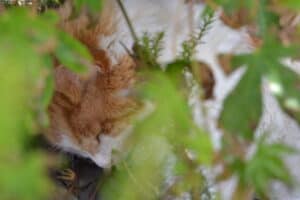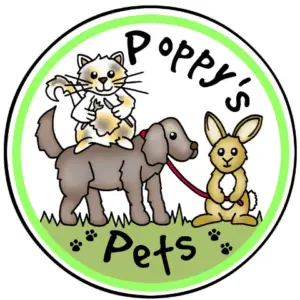Our pets live longer and are treated as part of the family, and seeing them suffer from any illness or injury is devastating. A decline in cognitive abilities characterizes dementia (Cognitive Dysfunction Syndrome) and is not limited to humans but can affect animals, particularly seniors. If your beloved pet has been diagnosed with dementia by a qualified vet, knowing what to do next can be overwhelming.In this article, we discuss the signs, the importance of making small changes in the home, and a complementary feed that may help slow cognitive decline.
What is Cognitive Dysfunction Syndrome?
CDS is another name for dementia. The condition is a degenerative brain disease with signs developing as your cat or dog’s brain ages.
Dementia causes everyday behaviour changes – the signs to look out for:
- Inability to learn new tricks or commands
- Forgetting house training
- Pacing
- Sat facing a wall
- General confusion in the home
- Howling or meowing loudly through the night
- Unable to tolerate rough and tumble with other pets or children
- Because of the above, dogs may become aggressive and cats may lash out with a paw
- Forgetting to eat
The statistics show that cognitive decline can affect 50% of dogs aged 11+ (also subtle changes may occur from 8 years old) and 68% in dogs aged 15+. In cats, the brain can begin to decline around 12 years old but typically from 15. The good news is that not every cat, dog, bird, rodent or rabbit will develop this condition. Any animal developing dementia will feel confused and frightened and needs its owner more than ever.
Akitivat is available for cats and dogs and can slow brain degeneration; it helped my geriatric cat Albert remember to eat. The product can be purchased online without a veterinary prescription. Alternatively, you can swap Akitivat for a veterinary own brand called RenewMe and lower the costs.
What are the signs of Dementia (Cognitive Dysfunction Syndrome)?

I adopted a 16-year-old deaf cat called Albert, and eventually, I noticed forgetfulness and howling at night and find him sitting facing the lounge wall for no apparent reason.
Below are tables outlining signs of dementia in cats and dogs.
Cats
| Vocalisation | Roaming |
| Disorientation | Toileting outside the litter tray |
| Reduced interest in play | Howling at night |
| Forgetting schedules (dinner time) | Forgetting to eat |
| Getting trapped or stuck in corners | Wandering aimlessly |
| Staring at walls | Withdrawn and depressed |
Dogs
| Vocalisation | Getting trapped or stuck in corners |
| Depression, anxiety, withdrawn | Disorientation |
| Inability to learn | Toileting indoors |
| Staring at walls | Pacing |
What do I do if I notice behavioural changes in my cat or dog?
It is easy to attribute minor behavioural changes to simple old age. And that may be all it is. I recommend keeping a diary detailing your pet’s behaviour, eating patterns, drinking, and toileting habits, which is especially handy if you need to relay them to your vet. It will help with a diagnosis. Your veterinary surgeon will examine your pet and suggest a blood test to rule out other conditions, such as pain, infection in the brain, deafness, blindness, and arthritis. I am not veterinary trained, so it is important to chat with your vet. This article is written from experience only.
So, because of my first-hand experience with the early stages of pet dementia, I suggest keeping your elderly dog on a lead when out walking and keeping your cat indoors unless you have a catio or cat-proof garden.
Check your garden for any hazards – it is about rethinking what is within the environment your pet and dog will live in. Make sure the garden is secure, so they cannot escape. Remember, your cat and dog are acting confused at home, so how will they survive outdoors if they get lost? They won’t. Many older pets lose sight and hearing, which will also hinder survival. At this stage, your pet needs your support more than ever.
My veterinary surgeon diagnosed dementia
Albert’s vet suggested I try a complementary feed called Aktivait. It is simple to use – just mix in with wet food or Weebox Lick-e-lix.
Watch the Video: It is easy to administer it if you have a cat or dog with memory loss.
Your veterinary surgeon will discuss medication appropriate for the early stages of dementia. Not many vets know of Aktivait, so please discuss it with your vet. The product can be purchased online from an approved pet pharmacy, but please look around as prices will vary, and some stores have discounts for first orders or free delivery.
To recap, Albert displayed the following:
- Staring at the walls
- Nighttime howling
- Forgetting to eat
- Deep sleep during the day
The RSPCA picked up Albert as a stray and weighed 2kg. Blood work revealed a thyroid issue and onset of kidney disease, so his weight fluctuated between 2.43kg and 3kg. Aktivait helped ease Albert’s signs.
How to administer tablet medication to your pet
Your vet may prescribe a tablet medication for dementia, or example, a thyroid condition. Albert’s vet opted for Aktivait for dementia and Vidalta tablet for his thyroid.
If you need to administer a tablet, then The EasyPill is an option. It is a flavoured, mouldable putty, and you push a tablet inside. However, getting your pet to eat it may be difficult because dementia can cause agitation if you get your pet to do something out of its normal routine, so you may need to improvise. Albert loved chicken, so I popped his tablet inside this, and he ate it.
How to give Aktivait powder to your pet

The powder comes in capsule form and a box of 60. As the daily feed worked through his system, his eating habits changed, and he ate a full sachet daily. Okay, it wasn’t much, but it was something. I sat with him as he ate and topped up his bowl with wet food, a spoonful at a time. I found this compelling too.
You need to re-think home and outdoor life with your pet
I recommend keeping to the same routine for the following:
- Food time
- Location of the feeding station
- Treat times
- The time you get up
- The time you go to bed
- Short dog walks
- Keep furniture in the same place
- Keep your pets’ bedding, water bowls etc. in the same place
- If possible, do not change anything
- Be observant of any dangerous hazards
Albert selected a spot in the kitchen to tell me he was hungry – he sat on an old kitchen sofa, so I fed him there. This was a habit during the evening but also periodically during the day. Because he ate very little, I fed him whenever he was hungry and giving him Aktivait seemed to help his memory and ease confusion.
Example of a cat becoming agitated when removed from a safe zone
You may find your pet becomes distressed during veterinary trips and at the practice. Events, changes in the environment, different scents or being handled by a stranger may make your pet anxious. It will depend on the stage the dementia is at and your pet’s past. Albert could not cope because of dementia and because it was obvious he had hardly been handled in his earlier life.
Albert was deaf too. In the consultation room, I would pick him up, cradle him, and murmur into his neck, hoping my voice’s vibrations and scent would soothe him. This theory was a success. Forewarn your vet that your pet gets agitated. Everything took longer than normal with Albert, and his senior vet became upset because the appointment overrun.
An animal will forget to groom itself and may need help washing. Claws must be cut as the layers build up and claws become thick and chunky. Nail clipping is free if registered under the Pet Health Care Scheme.
Fur will become matted too, so keep up with extra brushing. Because Albert was picked up as a stray, the RSPCA clipped him but he was still fairly matted. Eventually, Albert stayed at the vet’s for a day for a de-mat and blood tests.
How do you cope when your pet gets dementia?
It is an emotional rollercoaster, and so hard to see an animal you love lost in a world of confusion. Because Albert came to live with me at a geriatric age, the signs began quickly, so for me, it was how he was.
But one day, you know the brain has deteriorated so much that your pet does not remember who you are. Albert did not reach that level, but there will be many of you out there who have experienced the pain.
How are you supposed to feel throughout the worry and heartbreak?
You will have thoughts of:
Are you keeping your pet alive for you?
We all go through that, whatever the illness is. You may become deeply tired because the nighttime howling keeps you awake.
Unfortunately, dementia will worsen, but with Aktivait, love and patience may help. And please remember how much you are helping your pet and be proud of yourself.
Points to think of at home
I purchased two motion sensor battery-operated lights, which I placed in areas where Albert would walk. These lights reduced the nighttime howling by at least 80%. However, these are now unavailable. Recently (August 2022), we bought a pack of LED light strips for my cat Tabitha who went blind overnight.
I recommend buying lights with rechargeable batteries or a USB cable. Ours take standard batteries. But if buying with rechargeable batteries, you have the added expense of purchasing a battery charger.
Give your pet all your love. Do not punish them for any indiscretions. Watch your pet’s body language and general signs. Your dog may not tolerate other pets in the home, and when you go out, you may need to put them in separate rooms or use a baby gate. A dog or cat may become aggressive, but dementia causes behaviour changes. Young children might pull or cuddle your pet but may cause distress to your pet.
Be wary of obstacles around the house. What may not present a danger to us, will be a danger to a pet with dementia. I heard Albert howling, and I got up and came downstairs. My bra was dangling from the bathroom door handle and somehow Albert had put his head through the strap. When trying to free himself, the strap had tightened to a noose. It was terrifying, but because Albert had dementia, he sat there calmly. He was fine.
So ensure hazards in your home and garden are removed.
- Cables
- Straps
- Open cupboards
- keep walkways clear
- Open fires
- Full bathtubs and buckets
- Straps from handbags can be a danger
Related questions:
- Paws-itively amazing deals & sale products (included approved retailers)
- Aktivait – complementary feed to help dementia (recommended by my vet)
- Protecting a pet with dementia after your death
- Is my thin cat sick? – Hyperthyroid
- Does your pet insurance include a FREE video vet?
- Budget-friendly pet care – swap expensive products for lower-priced ones
Will my pet develop dementia?
Not necessarily, so please do not start worrying. Keep an eye on your cat or dog’s behaviour as they age. Molly was 20 and confused about where her litter tray was for a period, but it did not last. If you have any concerns, please talk to your vet.
I’m worried about who will look after my pet after my death
Please remember that your pet may outlive you, so please make provisions to keep your pet safe after your death.
Will my pet forget me?
Like humans with dementia, our pets may one day forget who they are. Dementia may or may not cause deterioration to the point they show you they are ready to ‘go’. Enjoying your time together and being there for one another is vital.
It is important to remember that your pet needs a quality of life and if they are suffering because they cannot function to their true abilities and are unhappy, then yes, it is time to say goodbye. That is the hardest thing for animal lovers especially if our furballs have been with us since a kitten or puppy.
In memory of Albert
My boy died unexpectedly in my arms on 7th January 2017 from a blood clot in his left leg. His weight was too low to operate. My boy just slipped away to Rainbow Bridge in seconds.
Disclaimer
This article does not give medical veterinary advice. Please consult your licensed veterinary surgeon for professional medical advice who will advise on health tests for your pet.
Poppys Pets is a participant in Awin and Amazon Associate affiliate programs which compensates me for referring traffic. It is of no extra cost to you and if thinking of buying a product, please consider using my link. It\'ll earn Poppy\'s Pets a few pennies to continue to this website. Only a selection of articles and videos on this website and YouTube channel contains affiliate links. Further information: Disclaimer and Privacy Policy

